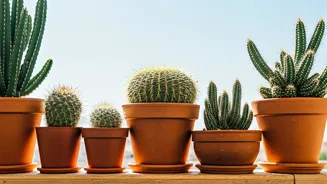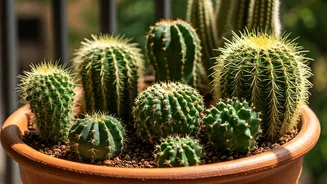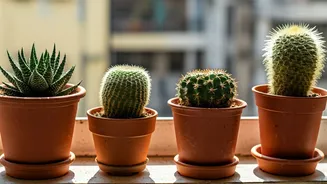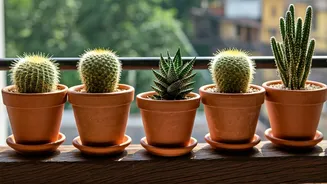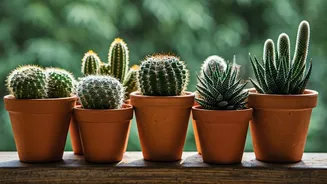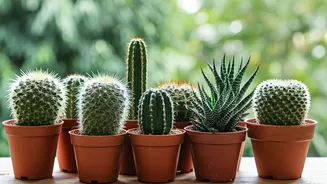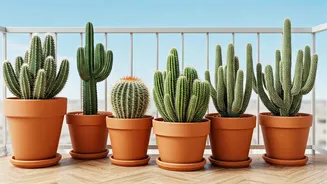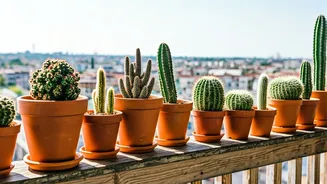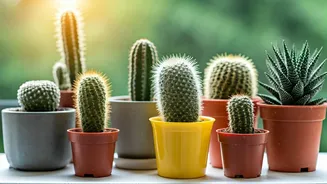Introduction: Cactus on Balconies
Balcony gardens provide a wonderful opportunity to integrate nature into urban living, and cacti are exceptionally well-suited to this concept. Their adaptability
to dry conditions and relatively low maintenance makes them perfect for the often-sunny and sometimes neglected spaces of a balcony. With a little knowledge of their specific needs, you can successfully cultivate a diverse range of cacti. This introductory section will provide an overview of the benefits of choosing cacti for your balcony, highlighting their resilience and suitability for the Indian climate. Cacti offer a fascinating variety of shapes, sizes, and even bloom colors, making them both visually appealing and educational.
The Prickly Pear Family
The Opuntia genus, commonly known as the prickly pear cactus, provides a diverse range of possibilities for your balcony garden. These cacti are easily recognizable by their flat, pad-like segments. They are exceptionally drought-tolerant, an essential quality for balcony gardens where water conservation can be a significant factor. Different Opuntia varieties bring unique textures and colors to your outdoor space, from the classic green pads to variations with reddish or purplish hues. Their relatively low maintenance and striking appearance make them a popular choice. Ensure proper drainage when planting them in pots to prevent root rot. Proper spacing is also important, allowing for growth and preventing overcrowding. Regular pruning, especially of dead or damaged pads, will maintain their health and visual appeal.
Saguaro's Miniature Cousins
Though iconic for the American Southwest, miniature versions of the majestic Saguaro cactus can find a home on your balcony. These slower-growing cacti bring the grandeur of the desert landscape in a smaller, more manageable scale. Their columnar shapes, often with characteristic ribs, add vertical interest to any balcony garden. While they require plenty of sunlight, they also tolerate neglect once established, which suits busy lifestyles. Saguaro cacti are well-adapted to hot and dry environments. Select a well-draining potting mix, composed primarily of sand and gravel. Water sparingly, and only when the soil is completely dry. Be patient, as these cacti grow slowly, but their unique structure is rewarding for the dedicated balcony gardener.
Barrel Cactus Charms
Barrel cacti, with their rounded shapes and often vibrant spines, add visual texture and architectural interest to a balcony garden. They come in various sizes, offering options to fit different balcony scales. These cacti have the remarkable ability to store large quantities of water within their stems, making them well-suited to periods of drought. Providing them with ample sunlight is critical, as it supports both growth and flowering. The bright yellow or orange flowers of certain barrel cacti species are a spectacular addition to any balcony setting. Choose pots with good drainage and plant them in a cactus-specific mix to ensure healthy root development. Avoid overwatering; allow the soil to dry out between watering sessions to maintain optimal health.
The Mammillaria Marvels
Mammillaria cacti are a diverse genus, popular for their variety of shapes, sizes, and flowering habits. They have rounded or cylindrical bodies, often covered in small tubercles. Many Mammillaria species produce attractive flowers, adding a splash of color to your balcony throughout the year. These cacti prefer bright, indirect light, so positioning them strategically on your balcony is essential. They are typically easy to care for, requiring infrequent watering and well-draining soil. Their compact size makes them ideal for smaller spaces, and they provide an excellent opportunity to experiment with various forms and colors. Regularly inspect for pests and diseases, and provide appropriate treatment if necessary, to ensure the health of your Mammillaria cacti.
Echinopsis Elegance
Echinopsis cacti, known for their stunning flowers, transform a balcony garden into a focal point during their blooming season. These cacti often have large, showy blooms that emerge at night, creating a magical spectacle. Echinopsis cacti vary in shape, from spherical to columnar, providing design versatility. They need plenty of sunlight to thrive and flower. They do best in well-draining soil and are moderately drought-tolerant, similar to other cacti. Be mindful of their watering needs, avoiding overwatering to prevent root rot. Many species produce offsets or 'pups' that can be easily propagated, allowing you to expand your collection. Consider incorporating different Echinopsis varieties for a year-round display of foliage and flowers.
Caring for Your Cacti
Success with balcony cacti depends on several key care practices. Proper sunlight is crucial: most cacti need at least six hours of direct sunlight. Choosing the right soil mixture is also essential; a cactus potting mix, providing excellent drainage, is highly recommended. Watering should be infrequent, typically once every two to four weeks during the growing season. Allow the soil to dry out completely between waterings to prevent root rot. Fertilizing sparingly is important; use a balanced fertilizer formulated for cacti during the growing season. Protecting your cacti from excessive rain and cold temperatures is also recommended. Regular inspection for pests and diseases and providing appropriate treatment is crucial to maintaining the health and aesthetics of your cactus collection.
